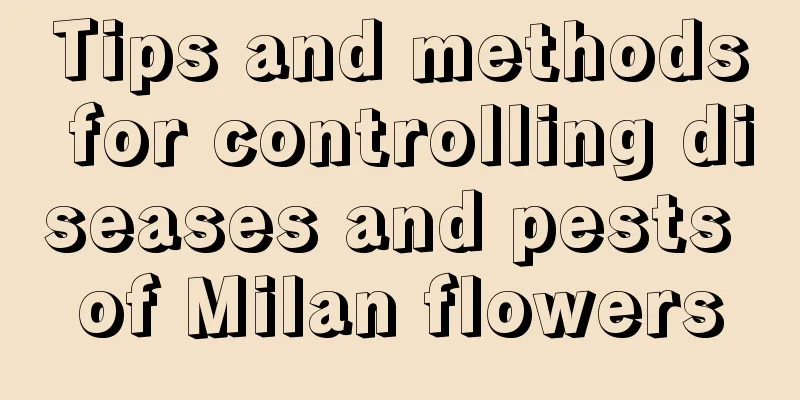Tips and methods for controlling diseases and pests of Milan flowers

|
Milan is also called Four-season Milan. Its leaves are round and small, the leaf color is emerald green, and the golden flowers look like strings of yellow millet , hence the name. When planting Milan flowers , improper management can easily lead to diseases and pests. Here are some tips and methods for controlling diseases and pests of Milan flowers. 1. Anthrax In the early stage of anthracnose, the leaf tips and edges turn brown and gradually spread to the leaves, with the edges of the spots becoming more obvious. When the petiole is first infected, the diseased part turns brown and spreads to the leaves. After the disease occurs, the leaves and petioles fall off until the branches are bare and dry up and die. Prevention and control techniques: In the initial stage, spray 70% thiophanate-methyl 800-1000 times diluted; 1% Bordeaux mixture; 80% anthracnose 400-800 times diluted; 50% captan 500 times diluted and other fungicides . 2. Scale insects Nymphs and adults gather on the back of leaves and branches to suck sap, causing the leaves and branches of Milan to turn yellow, the branches to wither, causing leaves to fall, and even the whole plant to die. Prevention and control tips: During the peak period of egg hatching, spray 1000 times diluted 25% phosmet emulsion; 1000 times diluted 50% malathion emulsion and other agents once every 10 days, and spray 2 to 3 times in a row. If the scale has already formed, 3-5 grams of 5% tifluanid and 10-15 grams of 3% fenvalerate can be buried in the flowerpot; or 1500 times diluted 40% cypermethrin emulsifiable concentrate can be sprayed. 3. Rust Milan leaves have small blisters on the lower or upper surface, containing yellow or rusty powdery spores. Prevention and control tips: In the early stage of the disease, spray 2000 times diluted 15% triadimefon wettable powder for prevention and control. 4. Sooty Disease Black water-like spots appear on the leaves, the spots spread, and the plants gradually wilt. Sooty disease is mostly caused by a hot and stuffy environment and poor ventilation. Prevention and control tips: Rinse leaves and branches with water, or spray with 1000 times diluted 70% methyl thiophanate. 5. Chlorosis Milan yellowing is more common. At the turn of spring and summer, when the temperature is high and there is a lot of rain, the lack of green in the new leaves is more obvious, which can not only cause the branches to wither, but in severe cases it can be fatal. Prevention tips: During hot summer weather, keep the room ventilated by opening windows or using fans to provide proper air circulation. That’s it |
<<: How to fertilize mint and what fertilizer to use
>>: How to fertilize lilac, what fertilizer is best
Recommend
How to change the soil of a money tree
When should I change the soil of the money tree? ...
Spinach planting, cultivation and management technology
Spinach is one of the vegetables commonly grown b...
Pothos and Clivia... grow too slowly? Learn 2 tricks, climb up the wall, the leaves are green and shiny!
Why does the green radish grow slowly? Every time...
How to prune the roots of Acorus calamus
Does Acorus calamus need root pruning? Root pruni...
How to plant avocado seeds, avocado pictures
1. Seed processing When planting, take seeds from...
The efficacy and function of lacquer
1. Relieve cough and reduce phlegm Zeqi has a ver...
What to do if the leaves of Cyperus rotundus turn yellow
Reasons for yellowing leaves In fact, it is inevi...
Can the dragon claw locust be planted in the yard?
Can I plant Sophora japonica in the yard? Sophora...
How to deal with root rot of dragon beard tree
1. Pruning When the roots of the dragon beard tre...
How to repot bougainvillea
Repotting time Bougainvillea is usually repotted ...
Can cucumbers be grown in pots?
Can cucumbers be grown in pots? Cucumbers can be ...
How to water the lucky tree
1. Determine the watering method Before watering ...
How to prune crape myrtle
Pruning methods Crape myrtle is generally pruned ...
How to make the Queen Ruyi famous? How to make the Queen Ruyi famous
1. Suitable soil If you want to keep the Queen Ru...
Native tree species
1. Cypress Cypress is an evergreen tree or shrub ...









